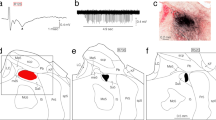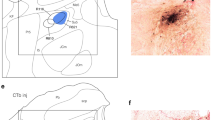Abstract
Retrograde transport and intra-axonal labeling studies provide convincing evidence that jaw-muscle spindle afferents project to the caudal medulla by way of Probst’s tract. However, functional properties of this caudal projection are not well understood. Extracellular recordings were made in cats at the level of the subnucleus interpolaris (Vi) to identify single units that showed consistent responses to ramp-and-hold stretches of the jaw. In this report, we present data from 20 central units with properties indicating that they received input from trigeminal muscle spindle afferents. All units were activated by gentle palpation of jaw muscles, and none had superficial receptive fields. Two groups of neurons could be defined based on their responses to passive jaw movements. One group (n=12) showed an obvious dynamic response (i.e., a higher level of activity at the onset of stretch than during the hold period). Activity was maintained during the hold phase, and the units stopped firing (unloaded) for a brief period upon jaw closure. The other group (n=8) lacked a dynamic response. Instead, they showed an increase in firing with onset of stretch that was maintained during the hold phase. Thirteen units, which were tested with more than three different jaw stretch speeds and/or amplitudes, were further characterized by analyzing dynamic index (DI) and mean firing rate (MFR) during each phase of the ramp-and-hold movement as well as interspike interval (ISI) variability. All but one unit with a dynamic response showed a speed-sensitivity. In all cases, the MFR was a more sensitive indicator of changes in jaw speed than DI. Neurons in the other group (5/5 tested) showed a high position-sensitivity, i.e., their firing rates varied as a function of amplitude of jaw opening. The percent change in ISI variability for all neurons ranged from 37–84%. The response characteristics of these central neurons were compared to known physiological properties of muscle spindle afferents. The results provided compelling evidence for jaw-muscle-spindle afferent projection onto these neurons. Reconstruction of recording sites showed that medial Vi, and the adjacent reticular formation, are likely recipients for the caudal projections from jaw-muscle-spindle afferents. We suggest that muscle spindle input to this region is well suited for influencing the coordination of motor behavior during feeding and for the integration and processing of kinesthetic information.
Similar content being viewed by others
Author information
Authors and Affiliations
Additional information
Received: 22 December 1998 / Accepted: 7 May 1999
Rights and permissions
About this article
Cite this article
Ro, J., Capra, N. Physiological evidence for caudal brainstem projections of jaw muscle spindle afferents. Exp Brain Res 128, 425–434 (1999). https://doi.org/10.1007/s002210050865
Issue Date:
DOI: https://doi.org/10.1007/s002210050865




